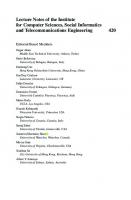Body Area Networks. Smart IoT and Big Data for Intelligent Health: 15th EAI International Conference, BODYNETS 2020, Tallinn, Estonia, October 21, ... and Telecommunications Engineering) 3030649903, 9783030649906
This book constitutes the refereed post-conference proceedings of the 15th International Conference on Body Area Network
188 51 12MB
English Pages 228 [234] Year 2021
Table of contents :
Preface
Organization
Contents
Connectivity and Radio Propagation
Providing Connectivity to Implanted Electronics Devices: Experimental Results on Optical Communications Over Biological Tissues with Comparisons Against UWB
1 Introduction
2 Optical Communications Through Biological Tissues
3 Radio, Acoustic and Optical Wireless Communications in Biological Tissues: A Comparison
3.1 Radio
3.2 Acoustic
3.3 Optical
4 Experimental Results
4.1 Optical Measurements
4.2 UWB Measurements
5 Discussion
6 Conclusion
References
On the UWB in-Body Propagation Measurements Using Pork Meat
1 Introduction
2 Study Case
2.1 Simulations
2.2 Measurements
3 Simulation Based Antenna Verification
4 Simulation Based Comparison Between the Channel Characteristics Obtained Using Human and Pork Tissues
5 Measurement Results
5.1 Channel Comparison with Different Meat Pieces
6 Impact of the Temperature
7 Conclusions
References
Detection of Brain Hemorrhage in White Matter Using Analysis of Radio Channel Characteristics
1 Introduction
2 Study Case
2.1 Directive on-Body Antenna
2.2 Simulation Models
3 Power Flow Analysis
4 Channel Characteristics Analysis
5 Conclusions
References
UWB Microwave Imaging for Inclusions Detection: Methodology for Comparing Artefact Removal Algorithms
1 Introduction
2 Theoretical Framework
3 Methodology
3.1 Ideal Image Construction
3.2 Artefact Removal Methods
3.3 Comparison Methods
4 Results
5 Discussion and Conclusion
References
BSNCloud: Cloud-Centered Wireless Body Sensor Data Collection, Streaming, and Analytics System
1 Introduction
2 Related Works
3 System Architecture
4 Data Aggregator Design
4.1 Data Aggregator Functions
4.2 Data Streaming
4.3 Real-Time Data Analysis
5 Cloud Server Design
6 Implementation and Performance Evaluation
6.1 Android App
6.2 Web Portal
6.3 Experimental Results
7 Summary
References
Secure Communication Networks for Smart-Health
Model-Based Analysis of Secure and Patient-Dependent Pacemaker Monitoring System
1 Introduction
2 Related Work
3 Pacemaker Background
3.1 Pacing
3.2 Monitoring and Alerting
3.3 Pacemaker Security Countermeasures
4 UPPAAL Probabilistic Timed Automata
5 Pacemaker Monitoring and Dynamic Alert Model
5.1 Patient Profiles
5.2 Modeling Alerting Cost, Parameters and Constants
5.3 Pacemaker Model
5.4 Pacemaker Model Analysis
6 Conclusions
References
Amplitude Modulation in a Molecular Communication Testbed with Superparamagnetic Iron Oxide Nanoparticles and a Micropump
1 Introduction
2 Testbed
2.1 Information Carriers
2.2 Transmission Channel
2.3 Transmitter
2.4 Receiver
3 Data Transmission
3.1 Encoding
3.2 Decoding
4 Results
4.1 Injection Volume Correlation
4.2 Data Transmission
5 Conclusion
References
An Enhanced DNA Sequence Table for Improved Security and Reduced Computational Complexity of DNA Cryptography
1 Introduction
2 Related Work
3 Proposed DNA Table
3.1 Entropy
3.2 Entropy Calculation for DNA Table
4 Experimental Results
4.1 Frequency Analysis of Encoded Text
4.2 Computational Time of Encoding Process
4.3 Frequency Analysis of Ciphertext
4.4 Computational Time of the DNA Encryption Technique
4.5 Entropy Analysis
4.6 Conditional Entropy
5 Conclusion
References
Solving Generic Decision Problems by in-Message Computation in DNA-Based Molecular Nanonetworks
1 Introduction
2 Preliminaries for Tile-Based Self-Assembly
3 DNA-Based Nanonetworks
3.1 Message Molecules
3.2 Forming Ligands
3.3 Message Receptors
4 Creating Generic Message Molecules
5 Arbitrary Nanonetworks for Boolean Formulas
6 Conclusion and Future Work
References
A Model for Electro-Chemical Neural Communication
1 Introduction
2 Biological Background of Neuro-Spike Communication
3 Neuro-Spike Communication Model
3.1 Transmitter (Presynaptic Neuron)
3.2 Synaptic Channel
3.3 Receiver (Postsynaptic Neuron)
4 Nervous Spike Detection
5 Discussion on Nervous System Diseases and the Impact of Medicines on Neuro-Spike Communication Performance
6 Numerical Results
7 Conclusion
References
Connected Wearables Sensors for Healthcare Applications
Activity Monitoring Using Smart Glasses: Exploring the Feasibility of Pedometry on Head Mounted Displays
1 Introduction
2 Related Work
3 Sensor Platforms and Pilot Experiments
3.1 Step Detection on the Smart Glass
3.2 Step Detection on IMUs
4 Methods
4.1 Pre-processing
4.2 Combining the Axes
4.3 Peak Detection with Salience Algorithm
4.4 Signal Enhancement
4.5 Thresholding and Peak Detection
4.6 Error Determination
5 Results
5.1 Accuracy Comparison
5.2 Error Analysis
6 Discussion and Future Work
7 Conclusions
References
Real-Time Human Activity Recognition Using Textile-Based Sensors
1 Introduction
2 Related Studies
3 Activity Recognition System Using Textile-Based Sensors
3.1 Data Acquisition System
3.2 Preprocessing
3.3 Feature Extraction
3.4 Classification
4 Experiments
4.1 Experimental Framework
4.2 Dataset
4.3 Evaluation Criteria
5 Results
6 Conclusion
References
Extraction of Respiratory Signals and Respiratory Rates from the Photoplethysmogram
1 Introduction
2 Related Work
3 Proposed Algorithm
3.1 Peak Detection
3.2 Signal Quality Index
3.3 Estimation of Respiratory Rate
3.4 Data Fusion
4 Materials and Methods
5 Results
6 Conclusion
References
An Ultra-low-Power Integrated Heartbeat Detector for Wearable Sensors
1 Introduction
2 System Overview
3 Circuit Design
3.1 Amplifier A1
3.2 Amplifier A2
3.3 Threshold Comparator
3.4 Self-calibration Unit
4 Results
4.1 System-Level Model
4.2 Transistor-Level Simulations
5 Conclusion
References
Anxiety Detection Leveraging Mobile Passive Sensing
1 Background and Introduction
2 Framework
2.1 Server
2.2 eWellness Data Collection
2.3 Limiting Personally Identifiable Data Collection
3 Pilot Study Methodology
4 Results
5 Discussion
5.1 Relevant Features
5.2 Limitations of the Study
5.3 Accuracy of Labeling
5.4 Subject Heterogeneity
5.5 Usability
6 Conclusion
References
Author Index
Preface
Organization
Contents
Connectivity and Radio Propagation
Providing Connectivity to Implanted Electronics Devices: Experimental Results on Optical Communications Over Biological Tissues with Comparisons Against UWB
1 Introduction
2 Optical Communications Through Biological Tissues
3 Radio, Acoustic and Optical Wireless Communications in Biological Tissues: A Comparison
3.1 Radio
3.2 Acoustic
3.3 Optical
4 Experimental Results
4.1 Optical Measurements
4.2 UWB Measurements
5 Discussion
6 Conclusion
References
On the UWB in-Body Propagation Measurements Using Pork Meat
1 Introduction
2 Study Case
2.1 Simulations
2.2 Measurements
3 Simulation Based Antenna Verification
4 Simulation Based Comparison Between the Channel Characteristics Obtained Using Human and Pork Tissues
5 Measurement Results
5.1 Channel Comparison with Different Meat Pieces
6 Impact of the Temperature
7 Conclusions
References
Detection of Brain Hemorrhage in White Matter Using Analysis of Radio Channel Characteristics
1 Introduction
2 Study Case
2.1 Directive on-Body Antenna
2.2 Simulation Models
3 Power Flow Analysis
4 Channel Characteristics Analysis
5 Conclusions
References
UWB Microwave Imaging for Inclusions Detection: Methodology for Comparing Artefact Removal Algorithms
1 Introduction
2 Theoretical Framework
3 Methodology
3.1 Ideal Image Construction
3.2 Artefact Removal Methods
3.3 Comparison Methods
4 Results
5 Discussion and Conclusion
References
BSNCloud: Cloud-Centered Wireless Body Sensor Data Collection, Streaming, and Analytics System
1 Introduction
2 Related Works
3 System Architecture
4 Data Aggregator Design
4.1 Data Aggregator Functions
4.2 Data Streaming
4.3 Real-Time Data Analysis
5 Cloud Server Design
6 Implementation and Performance Evaluation
6.1 Android App
6.2 Web Portal
6.3 Experimental Results
7 Summary
References
Secure Communication Networks for Smart-Health
Model-Based Analysis of Secure and Patient-Dependent Pacemaker Monitoring System
1 Introduction
2 Related Work
3 Pacemaker Background
3.1 Pacing
3.2 Monitoring and Alerting
3.3 Pacemaker Security Countermeasures
4 UPPAAL Probabilistic Timed Automata
5 Pacemaker Monitoring and Dynamic Alert Model
5.1 Patient Profiles
5.2 Modeling Alerting Cost, Parameters and Constants
5.3 Pacemaker Model
5.4 Pacemaker Model Analysis
6 Conclusions
References
Amplitude Modulation in a Molecular Communication Testbed with Superparamagnetic Iron Oxide Nanoparticles and a Micropump
1 Introduction
2 Testbed
2.1 Information Carriers
2.2 Transmission Channel
2.3 Transmitter
2.4 Receiver
3 Data Transmission
3.1 Encoding
3.2 Decoding
4 Results
4.1 Injection Volume Correlation
4.2 Data Transmission
5 Conclusion
References
An Enhanced DNA Sequence Table for Improved Security and Reduced Computational Complexity of DNA Cryptography
1 Introduction
2 Related Work
3 Proposed DNA Table
3.1 Entropy
3.2 Entropy Calculation for DNA Table
4 Experimental Results
4.1 Frequency Analysis of Encoded Text
4.2 Computational Time of Encoding Process
4.3 Frequency Analysis of Ciphertext
4.4 Computational Time of the DNA Encryption Technique
4.5 Entropy Analysis
4.6 Conditional Entropy
5 Conclusion
References
Solving Generic Decision Problems by in-Message Computation in DNA-Based Molecular Nanonetworks
1 Introduction
2 Preliminaries for Tile-Based Self-Assembly
3 DNA-Based Nanonetworks
3.1 Message Molecules
3.2 Forming Ligands
3.3 Message Receptors
4 Creating Generic Message Molecules
5 Arbitrary Nanonetworks for Boolean Formulas
6 Conclusion and Future Work
References
A Model for Electro-Chemical Neural Communication
1 Introduction
2 Biological Background of Neuro-Spike Communication
3 Neuro-Spike Communication Model
3.1 Transmitter (Presynaptic Neuron)
3.2 Synaptic Channel
3.3 Receiver (Postsynaptic Neuron)
4 Nervous Spike Detection
5 Discussion on Nervous System Diseases and the Impact of Medicines on Neuro-Spike Communication Performance
6 Numerical Results
7 Conclusion
References
Connected Wearables Sensors for Healthcare Applications
Activity Monitoring Using Smart Glasses: Exploring the Feasibility of Pedometry on Head Mounted Displays
1 Introduction
2 Related Work
3 Sensor Platforms and Pilot Experiments
3.1 Step Detection on the Smart Glass
3.2 Step Detection on IMUs
4 Methods
4.1 Pre-processing
4.2 Combining the Axes
4.3 Peak Detection with Salience Algorithm
4.4 Signal Enhancement
4.5 Thresholding and Peak Detection
4.6 Error Determination
5 Results
5.1 Accuracy Comparison
5.2 Error Analysis
6 Discussion and Future Work
7 Conclusions
References
Real-Time Human Activity Recognition Using Textile-Based Sensors
1 Introduction
2 Related Studies
3 Activity Recognition System Using Textile-Based Sensors
3.1 Data Acquisition System
3.2 Preprocessing
3.3 Feature Extraction
3.4 Classification
4 Experiments
4.1 Experimental Framework
4.2 Dataset
4.3 Evaluation Criteria
5 Results
6 Conclusion
References
Extraction of Respiratory Signals and Respiratory Rates from the Photoplethysmogram
1 Introduction
2 Related Work
3 Proposed Algorithm
3.1 Peak Detection
3.2 Signal Quality Index
3.3 Estimation of Respiratory Rate
3.4 Data Fusion
4 Materials and Methods
5 Results
6 Conclusion
References
An Ultra-low-Power Integrated Heartbeat Detector for Wearable Sensors
1 Introduction
2 System Overview
3 Circuit Design
3.1 Amplifier A1
3.2 Amplifier A2
3.3 Threshold Comparator
3.4 Self-calibration Unit
4 Results
4.1 System-Level Model
4.2 Transistor-Level Simulations
5 Conclusion
References
Anxiety Detection Leveraging Mobile Passive Sensing
1 Background and Introduction
2 Framework
2.1 Server
2.2 eWellness Data Collection
2.3 Limiting Personally Identifiable Data Collection
3 Pilot Study Methodology
4 Results
5 Discussion
5.1 Relevant Features
5.2 Limitations of the Study
5.3 Accuracy of Labeling
5.4 Subject Heterogeneity
5.5 Usability
6 Conclusion
References
Author Index

- Author / Uploaded
- Muhammad Mahtab Alam
- Matti Hämäläinen
- Lorenzo Mucchi
- Imran Khan Niazi
- Yannick Le Moullec
- Similar Topics
- Computers



![Big Data Technologies and Applications: 10th EAI International Conference, BDTA 2020, and 13th EAI International Conference on Wireless Internet, ... and Telecommunications Engineering, 371) [1st ed. 2021]
3030728013, 9783030728014](https://ebin.pub/img/200x200/big-data-technologies-and-applications-10th-eai-international-conference-bdta-2020-and-13th-eai-international-conference-on-wireless-internet-and-telecommunications-engineering-371-1st-ed-2021-3030728013-9783030728014.jpg)



![IoT and Big Data Technologies for Health Care: Second EAI International Conference, IoTCare 2021, Virtual Event, October 18-19, 2021, Proceedings, ... and Telecommunications Engineering, 415) [1st ed. 2022]
9783030941819, 9783030941826, 3030941817](https://ebin.pub/img/200x200/iot-and-big-data-technologies-for-health-care-second-eai-international-conference-iotcare-2021-virtual-event-october-18-19-2021-proceedings-and-telecommunications-engineering-415-1st-ed-2022-9783030941819-9783030941826-3030941817.jpg)
![IoT and Big Data Technologies for Health Care: Second EAI International Conference, IoTCare 2021, Virtual Event, October 18-19, 2021, Proceedings, ... and Telecommunications Engineering, 414) [1st ed. 2022]
9783030941840, 9783030941857, 3030941841](https://ebin.pub/img/200x200/iot-and-big-data-technologies-for-health-care-second-eai-international-conference-iotcare-2021-virtual-event-october-18-19-2021-proceedings-and-telecommunications-engineering-414-1st-ed-2022-9783030941840-9783030941857-3030941841.jpg)
![Industrial IoT Technologies and Applications: 4th EAI International Conference, Industrial IoT 2020, Virtual Event, December 11, 2020, Proceedings ... and Telecommunications Engineering) [1st ed. 2021]
3030710602, 9783030710606](https://ebin.pub/img/200x200/industrial-iot-technologies-and-applications-4th-eai-international-conference-industrial-iot-2020-virtual-event-december-11-2020-proceedings-and-telecommunications-engineering-1st-ed-2021-3030710602-9783030710606.jpg)